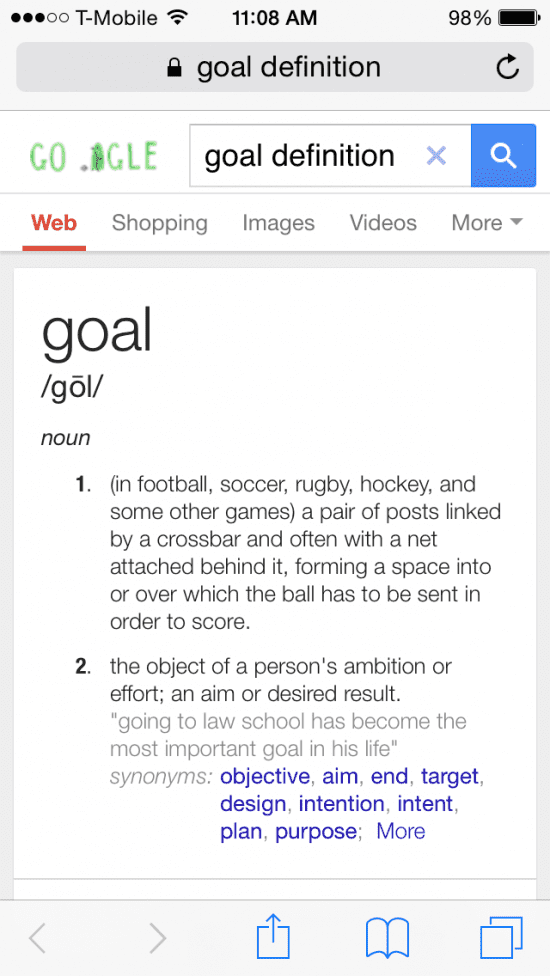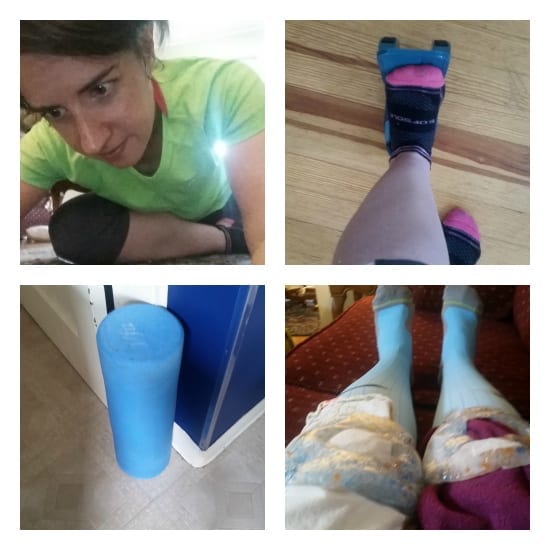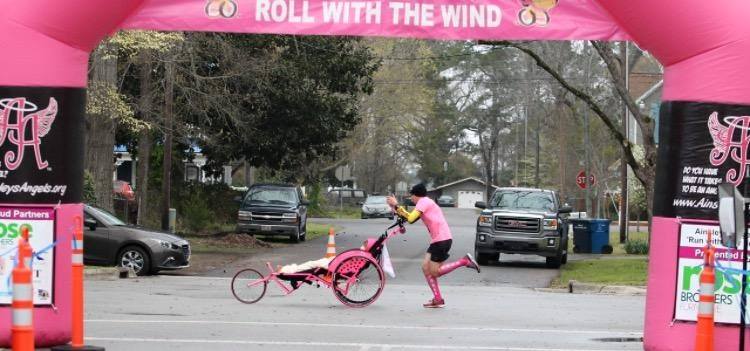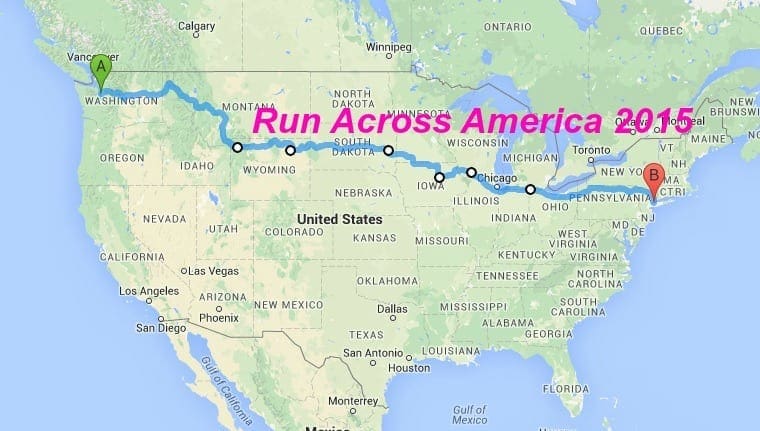One #FindYourStrongMarathon, Two Voices: Got Goals?
Heather and Marianne, two long-distance BRFs, are going to document their #FindYourStrong Marathon training weekly on Tuesdays. This week, they were inspired by Flackback Friday’s post on setting a marathon goal and report how that topic is feeling three weeks in.
Heather
My husband gave me a hand-written copy of this poem within two weeks of our first date. (Smooth, right?)
Less romantically, this quote also illustrates how I feel about running goals.
When I initially started thinking about this post, my first reaction was that I don’t have a lot of experience in goal-setting. I wasn’t an athlete growing up, and I don’t think I’ve set a weight loss goal in my life. But by Google’s definition, I’ve had many – big ones, too.
Get into the top vocal program in the country: check. Get a job in product marketing at Nike: check. Leave corporate and start a career in nonprofit: check.
When it comes to life, I’m a fairly confident person. In retrospect, it was pretty brash to only apply to one music school when I wanted to transfer. When I decided to leave corporate, I didn’t line up another job first, I just quit. I took a few months off to travel and felt certain that everything would work out. But for some reason, this confidence doesn’t translate to athletic goals.
I’ve been waffling on how to approach the Wineglass marathon from the time I signed up. My competitive nature and recent increase in speed is pushing me to set a time goal. But The Blerch in me whispers that it’s absurd to have a time goal for a first marathon and I should just be happy to finish. (This is the same Blerch that jeers “big deal – everybody runs marathons these days.” He sucks.)
In theory, running goals should be easier to hit than life goals. Unlike potty training or job searching, there’s a clear plan to follow and supposedly, if you follow that plan, you’ll hit your goal. But one lousy run and my mind goes straight to that dark, doubtful place. This week I had two of them. Tuesday’s prescribed “easy” 4 miles weren’t awful, but I felt leaden the entire time. Saturday’s long run – 12 miles – was similarly mediocre; my legs started feeling tired around mile 4. The pouring rain that arrived at mile 8 actually helped in that I stopped caring about pace and just focused on getting it done.
My biggest struggle is trusting the training plan. I understand the principle behind slowing down for the long runs. I get that the idea is to prepare your body to move for a longer stretch of time than you’re actively practicing. But when I’m feeling tired on a long run at a slower-than-race pace, it’s really difficult to feel optimistic about an even longer run at an even faster pace.
Despite all these head games, I’m hitting my training paces on the nose. And my BFF thinks I’m being ridiculous:
I guess it’s time to free my official goal from that secret space between the shadow and the soul. To decide that, like my life goals, I’m just going to make it happen. To trust the training plan and the smart woman that made it.
So without further ado, I’m putting it out there:
Sub-4:00:00.
Let’s do this.
Marianne
Here’s how I’m feeling about my only-want-to-finish goal at the moment.
I’ve just returned from the week 3 long run. I’m exploring some new roads and trusting that I can find my way home (and check google maps when I get nervous). I added a few park loops and got treated to some water.
Even better, my steady pace felt like I was moving but not suffering. Yet it was almost as fast as my Wednesday tempo pace (10:30) that felt hard. I know, objectively, my legs were in different places. Today they were well rested having been stretched by gentle yoga Wednesday afternoon and then treated to an off day on Thursday. In contrast, Wednesday’s tempo followed a HIIT class I was still feeling days later (so. many. squats.) and then an easy 4 on Tuesday. It’s also possible that Strava gave me some bonus mileage so my average was more like an 11:00 instead of the 10:40 it claimed I managed.
No matter what was real, I certainly wasn’t running at the 11:27 that will be used by the 5 hour pacer. I was closer to that of the 4:40:00 (10:41). And I wasn’t racing, I was running.
I registered for Wineglass in December with the idea that finishing was fine enough. But the winter #NoLimits half training showed me I have a lot of room for growth. One appealing element of going for 4:40:00 is that my training runs will take less time. As it is, today’s run was a 3.5 hour affair. In addition to the 2:20:00 of running, I woke up 30 minutes early to have something to eat and get all my fuel and hydration ready. (Today was Espresso Love and Tri Berry GU plus one bottle of Nuun and two of water, should you be into such details.) Then I walked a bit to cool down at the end.
And then there’s the post run litany to keep my body happy. Last week’s trip to the (amazing, wonderful, genius) chiropractor, Dr. Courtney Centrelli, revealed that I was getting tight glutes and calves. So in addition to my usual plan of rolling, icing, foot drills, and stretching I have been adding in the step stretch and pigeon pose.
I usually don’t mind this extensive regimen because I have eaten more race fees than I care to admit, often due to injury, but it does add significant post run time. So part of me says just finishing at all should be enough. But another part says if you’re going for it, why not really go for it?
And that part of my brain that is not so kind says “If you don’t push it, it doesn’t really count because it’s not hard enough.” You know, because running 26.2 miles isn’t enough to count as a worthy accomplishment. (Side note: this same voice says as such regarding being one and done with children, making decisions about work, quantity of volunteer commitments. quality of potluck contributions, etc.) Perhaps I should take a hint from the Runners World email I got today promising “Run Your First Marathon and Enjoy It” and let that be enough?
Readers, how do you decide when it is enough when it comes to goal setting?
AMR Running and Reading Club: Summer 2015 Installment
Summer is here, and it’s time for travel and adventure–and reading. We are combining all three in our newest installment of the Another Mother Runner Running and Reading Club. The book is titled Running Past Midnight: A Woman’s Ultra-Marathon Adventure, and it’s written by Molly Sheridan with Al Marquis.
An accomplished ultramarathoner and a mother runner (natch!), Molly takes the reader along as she covers 150 miles through the Sahara Desert in the Marathon Des Sables, 135 miles through Death Valley and up Mt. Whitney while racing the Badwater Ultramarathon, and points in between. Whether you dream of running an ultra or prefer to live vicariously through Molly’s non-fiction narrative while sipping an ice tea while lounging on a shady hammock, we believe passages of this book will touch and inspire you.
We will be hosting Molly as a guest on our podcast, recording on Wednesday, July 29, so you have more than a month to grab a copy of Running Past Midnight, be transported by its 204 pages, and pose your questions for Molly. We’ll ask for them on our Facebook page on Monday, July 27.
Until then: Enjoy the armchair (or hammock!) travel and adventure served up by this book! (And if you have books you think we should include as a future selection of AMR Running and Reading Club, please let us know via social media or a comment below this blog post.)
#166: Father Runner Running Cross-Country with Disabled Son
To commemorate Father’s Day, Dimity and Sarah are joined by Shaun Evans, a dad who is setting off from Seattle on July 4 to run across the country. As if running 3,200 miles in two months isn’t impressive enough (here’s the math: 53-55 miles/day for 60 straight days!), Shaun tells how he’ll be pushing his 8-year-old son, Shamus, who has cerebral palsy, in a deluxe stroller for most of the miles. Shaun shares how the epic journey, dubbed the Power to Push Run Across America, was dreamt up by Shamus after the father-son stroller-duo won (!!) a 6-hour ultramarathon together. Shaun talks about the power to endure and how the Power to Push will be helping other kids, “roll with the wind,” as Shamus sees it. And find out what part baseball plays in this inspirational cross-country trek.
*If you’re digging our podcasts, we’d be super-grateful if you’d take a minute (because we *know* you have so many to spare!) to write a review on iTunes. Many thanks.
**Also, the quickest way to get our podcasts is to subscribe to the show via iTunes. Clicking this link will automatically download the shows to your iTunes account. It doesn’t get any simpler than that
Flashback Friday: Setting Race Goals

The Twin Cities Marathon calls itself most beautiful urban marathon in America. Hard to argue with that.
We’re heading back to this post today since we’re feeling Minnesotah. I—Dimity—am in Duluth for Grandma’s Marathon Expo. If you’re reading this and happen to be in Duluth, please stop by at our booth and say hi. Also, I’ll be speaking at 2 p.m. today about maximizing race performance and enjoyment, so if you need a few tips on everything from taking a good race pic to pacing yourself well, I’m happy to oblige.
Sarah and I are taking to the Twin Cities streets on Sunday; Sarah will be running the full 26.2, while I’m running the 10-miler, aka The Shortcut to The Capitol.
We thought this would be a good opportunity to talk about how to set race goals for yourself. It can be tough because you don’t want to set them so high, you end up feeling like a failure at the finish line, but you also don’t want to short-change your training and effort.
We’re fans of multi-tiered approach–some time goals, some race-related goals, and maybe even some more personal goals–you are pretty much guaranteed to hit at least one of them, no matter what the clock reads or how you feel when you cross the finish line. Which means you have the respectful answer, “I met my goal,” to use on anybody who asks about your race but you don’t feel like digging into the nitty gritty.

This is the nut roll we met last time we were in the Twin Cities. It doesn’t really belong in this post, but I’m nutty like that.
Our Goals for Sunday
Sarah: Time Goals
Everything is perfect: sub-four hours. (Shocker, right?)
Everything is normal: “I’ll be bummed if I go over 4:08,” she told me the other day.
Dimity: Time Goals
Everything is perfect: sub 1:30. (Highly unlikely, since I haven’t seen many splits under 9:00 in the past 5 months; you have to train the way you want to race. And I really haven’t formally trained for this at all. But I’m going to sea level, and it’s a fairly flat course. Stranger things have happened.)
Everything is normal: 1:35 (Barring intestinal catastrophe, I know I can hold 9:30 splits at sea level for 10 miles.)
Sarah: Race Goal
To embrace the pain. “When I am at mile 19, if I’m hurting, I want to hang in there and not let myself ease up. I’ve had a perfect training cycle, and I’m more than two-thirds through the race. Why toss all that hard work away? I really want to leave it all on the course.”
Dimity: Race Goal
To start slow and gradually get faster. I am going to monitor my heart rate and get my mile splits. My soon-to-be-coach (for the Iron de Man training, which commences on 11/1!) wants me to run the last mile the fastest, if that’s possible. Even when I’m super trained, it’s super hard for me mentally to empty my tank, so to do so on Sunday would be a huge victory. I have no desire to embrace any pain. Regardless, I am going to take the first 6 or so miles at an easy, I can-hang-here pace.
Sarah: Personal Goal
To soak it all in. Ever since she got a course preview (in a car) by another mother runner last spring, she’s been drooling over the beautiful marathon course. So she wants to take in the lakes and the leaves and, most importantly, acknowledge and thank at least a handful of people cheering.
Dimity: Personal Goal
To get to the starting line feeling energized and happy. As I’ve written about before, taking care of myself on the road is not my forte. I am going to be sure to hydrate, sit down when there’s nobody at the AMR booth, eat well (I’ve already packed snack bags of almonds), and be asleep before 10 PM both nights (which is, yes, 9 PM my time…).
We’ll have a post next week where we grade our goals, but we want to know: do you set a range of goals for your races or focus on just one?
In Her Shoes: Learning How to Negative Split

Kerianne (left) and Jillian (right) looking lovely in pink.
Here’s one of the final episodes of In Her Shoes, tales that got left on the cutting room floor while writing Tales From Another Mother Runner.
I was running 15K near Vancouver, Washington, with two girlfriends. The course is mostly flat with a few good-sized hills. I wasn’t planning on racing; I was just running it because I do this event every year.
Around mile 2, my girlfriends and I were talking about husbands and this 70-year old guy who was near me started interjecting his marriage advice. His name was Patrick, and we ended up running together for quite a while.
Then we talked about running. He said he will never be as fast as he once was and how now when he races, it’s just a different race. It’s more just the fun of it. Plus, he always places in his age group because there are not a lot of people the 70- to 79-year-old category. He was really great company, but his pace was a bit slower than I had been running lately
The friends got further and further ahead of me. With about four miles to go, Patrick told me I should get going and join them. But I could barely see them.
I didn’t think I was going to catch up to them, but somehow I did. I just had this adrenaline. I usually start out slow anyway, then try to pick it up the second half, but this dialed up the intensity. I found myself at an uncomfortably hard pace but with enough energy to maintain it. Once I saw my friends, I thought, I’d already run this fast to get to them; I’m just going to go for it. A Beastie Boys’ song was playing at the finish line, and it propelled me across.
I definitely left everything I had on the course, which made me pretty happy. I saw my friends come in, congratulated them, then took off. I had errands to do. Hours later, one of my girlfriends called and said, “You placed second in your age group!”
I was totally shocked. Did nobody else enter in my age group or what? What the heck?
Patrick didn’t just teach me about marriage: He taught me something about saving myself in the early stages of the race so I could have gas in the tank at the end.
—Jillian (Favorite treat after a run is a tall bottle of HUB Seven Grain Stout. “Obviously healthy: seven grains!”)
My Most Important Mile: Learning to Swim by Denise Dollar

Denise, in the pool, just the way she likes it: in the shallow end where she can see the bottom.
We’re back with our occasional series Most Important Mile today, and since summer is here, we’ve diverted a bit to head to the pool. Actually, Denise Dollar, founder of Heart Strides, is the one getting wet. We’ll let her take it from here.
I have my first swimming lesson today.
I have been teary eyed all morning. I don’t have my period; in fact this is my ‘good’ week. Stumped by the surge of tears on this rainy day, I scramble for explanations, but come up with nothing. Aside from wanting to get my house organized and my laundry done, it’s a pretty typical day.
I read the email from my swim instructor over and over, to the point of nausea. “The warmth of your hand will start locker room’s key pad…goggles…bring a towel.” I check my backpack over and over again, planning my strategy, which feels both simple and impossible at the same time: Just show up. Get myself to the pool.
Unable to locate the case for my contacts, I become teary again. “It’s just a case, it’s okay,” I tell myself, “Plus, you can explain that you don’t typically wear contacts because your eyes get dry, you don’t wear goggles, you don’t open your eyes under water…”
I realize I am already over-explaining.
I grab my backpack and jump in the car. I’m about a block away from my house when I go over my checklist again. Towel. I forgot my towel. I turn around in a panic. I will be late for my first swimming lesson. I can’t be late.

“Water gives me strength—and at the same time is one of the biggest cracks in my foundation.”
Back on the road I think about how much I actually love the water. I love to be on it, near it…and in the shallow end of it. Ironically water gives me strength and brings me great peace.
I tear up again. Why? I still don’t know why. It’s raining out, I’ve been super busy. Just a good day to cry, I guess.
My lesson takes place about 14 minutes from my house. I know exactly where the pool is; there is no chance of me getting lost. Still, I find comfort in plugging the address into Google Maps. I check the distance, 6.2 miles, 4.3 miles, make sure I don’t missed my turn.
I wonder about how many adult learners skip their first swimming lesson.
I arrive and see two people coming out of the building. Do they know I can’t swim? Is it obvious? I’m pretty sure they know. I squeeze my towel under my arm and enter the building.
I find my way to the locker room and wipe away a few rogue tears as I wrestle with my swimsuit. Not a real swimmers swimsuit, I tell myself, just an I’m-a-mom-on-the-beach-who-wants-to-hide-her-hips kind.
I’m so out of my element.
Plus, I’m upset with the way my legs look in my suit. So stupid. You are here for a swim lesson, I tell myself. You are not here for a beauty pageant.
I enter the pool area. The chlorine smells intoxicating, the humid air, welcoming. I scan for someone who looks like an instructor. I think I spot her.
There are also two older men in the pool. Maybe in their 70’s? I’m envious. Not of their courage to wear a Speedo, but of their comfort in the water.
I scramble over to where my instructor is, stand on the pool deck, and talk really fast. I can’t stop myself. She seems a bit puzzled, but at the same time familiar with my behavior.
She quietly says, “Well…why don’t you come in?” and points to the stairs along the side of the pool. I climb down the ladder, holding on to the railings so I don’t kerplunk into the water.

Raised in Florida, Denise and her baby bro had plenty of beach time.
We stand there for a minute, face to face. She doesn’t prompt me, but my nerves kick in and I am suddenly talking about how excited I am to learn how to swim, how I really want to do a triathlon, how I really want to be confident in the water, how I really want to be there for my kids. I tell her that when my kids were born, learning to swim was always something that I wanted to do. I didn’t want be afraid of them going out to far, unable for me to reach them, to save them from harm.
Save them from harm. The words stick to my heart like glue.
I see her looking at me, her eyes searching for a calm connection. Then she says something to me, which I can’t recall now, but it prompts me to share about my two near drowning experiences.
The first one happened when, on a road trip, we stopped in Texas to visit my aunt and uncle. We were playing in the hotel swimming pool, a large kidney-shaped pool with a bridge going across the middle, dividing the shallow and deep ends. I was 11 years old.
I didn’t know how to swim then, but my uncle said he would help me learn. Next thing I knew we were standing on the diving board. He stood there with me, convincing me he would hold on to me and we would jump in together. He would be with me if I needed him. I still remember the weight of his arm resting around my waist. I never doubted he would follow me in. “I won’t let go,” he said, “I promise.”
I jumped.
He didn’t.
I remember feeling panicked by the time I hit the water. I remember willing myself up to the top, crying and coughing. He came to the side of the pool to help me out, I think—or I want to remember it that way.
After that I don’t remember much, other than my Mom being completely furious with him.
That was more than 30 years ago.
“It’s okay to cry,” my instructor says, “It’s actually really good for you to let it out…a lot of people cry at their first lesson. Some people don’t even show up.”
I take a deep breath, apologize, wipe away the tears and tell her I’m ready.
We do a couple of simple exercises, and she suggests we walk to the deeper end of the pool, reassuring me I will still be able to touch the bottom. As we walk she asks if it was difficult to get to the lesson. I start rambling off about forgetting my towel and hitting every red light.
She waits until I finish and she says, “No, I meant was it difficult emotionally to get here today.”
I want to look at her with dry eyes and a strong heart and say, “Piece of cake…” but instead I tear up again and explain I was teary all morning over the oddest of happenings.
Now it’s starting to make sense. Fear of the deep end; fear of not being able to touch the bottom; fear of getting pushed in.
I share the second experience. I was in my early teens, with a friend who had invited me and some other friends to the lake. I remember being nervous, praying that there would be no rough housing in the canoe or sudden swim opportunities. I remember being on a raft; we had taken a small boat to a raft and we were all on it, soaking up the sun.
The driver of the boat left and I started to panic about how we would get off of the raft. I kept it to myself, too embarrassed to tell my friend that I couldn’t swim.
They all jumped in and started swimming to shore. I sat on the edge of the raft trying to figure out how I could just ‘drop in’ and somehow get to the shore. It didn’t seem that far. People were yelling at me to Hurry up! Jump in! Come on! So I jumped.

Learning to swim for herself—and for her kiddos.
I sank to the bottom and got stuck in the muck for what seemed like forever. The top of the water seemed unreachable. By then my friend realized I was in trouble and she came out to help me back to shore.
My instructor looks at me with gentle eyes. “Such appropriate behavior for a teenager to not want to be embarrassed,” she says.
We do a few more exercises. I make an appointment for another lesson. I feel good.
On the way home I think about trauma. How it can’t be measured, how quickly the body absorbs it, and how long very, very, long it can hold on to it. I’ve held onto this trauma long enough.
I think about how empowering it will be to feel confident in the water. The deep water.
I also wonder why I didn’t take lessons earlier. I cry again.
Mostly though, I think about how learning to swim isn’t really about learning the strokes.
It’s about showing up and getting in the deep water when I’d really rather be on the shore.
What was (or will be) the most important mile? Share it with us! Best way to submit is to email us your story with a picture: runmother {at} gmail {dot} com with “Most Important Mile” in the subject line. Please try to keep your mile stories around 400 words. Thank you!














